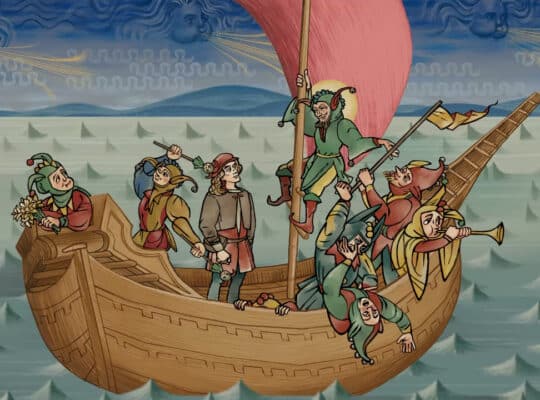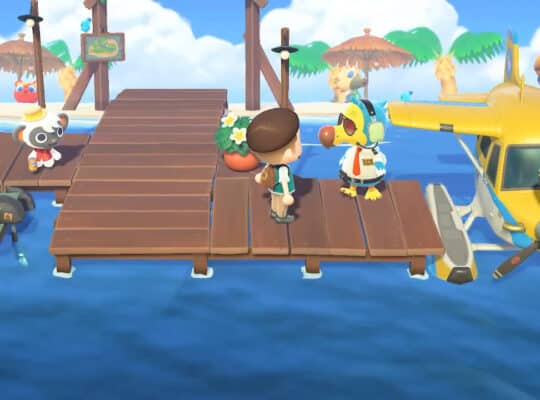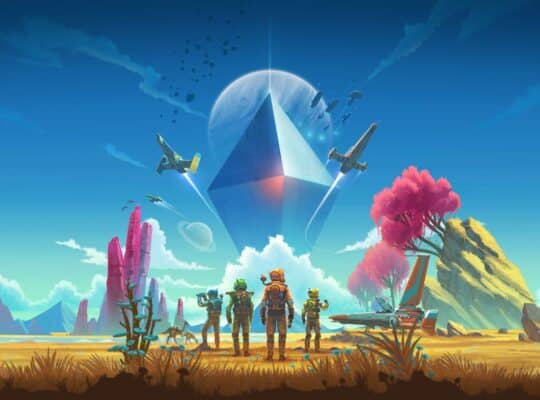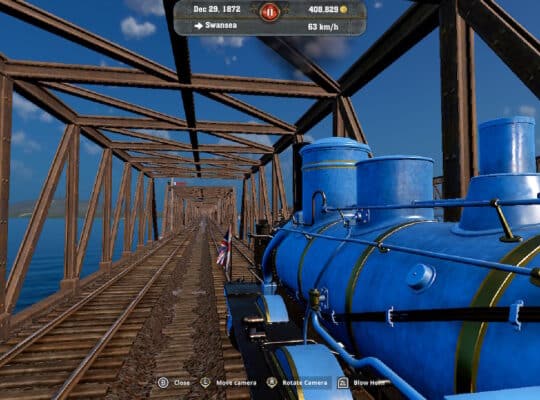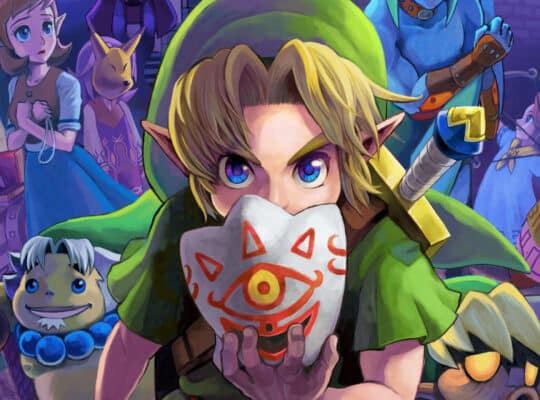No Man’s Sky celebrated its eighth anniversary this past weekend, an amazing milestone for any game in its own right, but an even bigger achievement for Sean Murray and the team at HelloGames considering its rather tumultuous launch. No Man’s Sky had the cards stacked against it, pressures on an indie studio by a large publishing partner, hype it almost certainly couldn’t live up to, and a clamoring fanbase expecting not only the world but a procedurally generated universe. Some would be quick to dismiss its launch and label it a commercial failure, but 8 years later, it’s still on the charts and in our hearts as one of the greatest comeback stories in gaming history. With that in mind, let’s take a look at how No Man’s Sky refused to be grounded…

No Man’s Sky was announced by Sony as a PS4 exclusive game at the 2014 E3 Convention to much hype and excitement. The trailer was mind-blowing, showing off unique life forms, planets that felt alive, and intense multi-planetary dog fights with wingmen. It was a concept that was hard to believe on paper, an infinite digital universe with an infinite amount of planets and creatures to discover… a seemingly endless game. Sean Murray announced in 2016 that the game would be delayed and not make its June release date, something that set off the fanbase and lead to the team receiving death threats. On July 8th, Murray and the team announced via Twitter that No Man’s Sky had gone gold, and would land on the PlayStation 4 on August 9th, re-invigorating the fanbase and causing an intense amount of hype.
No Man’s Sky released and I remember my friends and I all going out to grab a copy to meet up at my place and play. The anticipation and excitement were palpable, we stocked up on snacks and prepared to pull an all-night gaming session. The wave of launch day reviews sitting on average at 6/10 did little to bring our spirits down, we were hyped. We had dinner while our consoles updated and vowed to meet up in space to form a fleet of fighters to explore the galaxy, spurred on by the trailers. None of that was meant to be, however, as we scurried on our respective planets to repair our ships only to realize that there was no actual multiplayer. Disappointed, we trudged on looking to uncover the secrets of the universe only to find there just wasn’t much to do. The game was basically a grind to gather resources, make minimal upgrades, leave the system, rinse and repeat. I played sporadically for a few weeks after launch, but much like my friends, I decided to play other games.
It wasn’t just the critics that No Man’s Sky was poorly received with this sentiment being shared among a lot of fellow gamers as well. Initial sales within the first month were estimated to be close to the 800,000 mark, with an estimated 60,000 refunds given. Both Sony and Valve’s Steam Sales platform held off on granting refunds, with Sony insisting the game is being improved, and Valve adding a special Public Service Announcement on the No Man’s Sky listing stating there are no special exceptions to Steam’s refund policy due to the player base dropping a whopping 89% after the first month. No Man’s Sky it would seem, would go down as a lesson in hype and failure for future generations to study. Retailers moved to reduce on-hand stock, with companies like GameStop and EB Games having plenty of secondhand copies due to the wave of trade-ins on the game. Both disgruntled gamers and the media’s voices grew louder, and Murray and the team went radio silent, seemingly hiding from the growing wave of criticism.
With no word from Murray and the team, apart from Murray seemingly backtracking on free DLC updates, it was evident to players that the future of the game was more an imploding black hole than a shining star, and speculation was rife about what happened, with online forums and social media further amplifying dissonance about the title. Many people started shifting blame towards Sony, theorising that they were responsible for pressuring Murray and the HelloGames team to release the game well before it was ready, and even using its advertising spend to push false advertising to mislead consumers. It’s still not entirely clear what happened in the months leading up to the launch, but it was clear what consumers got wasn’t what they saw in the trailers, or even the debut E3 trailer. The void of silence was filled with angry consumers, and on the outside, it appeared the title was dead in the water merely months after release. That could have been the end of it, but it turns out that while Murray was silent, he wasn’t in hiding, he was setting out to make the game he promised and do his best to win over the critics.
Three months after the disastrous launch campaign, HelloGames announced the first free update for No Man’s Sky in the form of Foundation, aptly named to lay the basis for what was to come. Foundations added in base building and freighters, giving players more to do in the game. It wasn’t an update to turn things around, more a promise from Murray and the team that they hear feedback, and are working towards making things right. In March 2017, Hellogames announced its next free update: Pathfinder, adding planetary vehicles and base sharing into the game. It also allowed players to collect and use multiple starships and gave players ownership over their creations by allowing them to share bases for people to visit. While multiplayer was still absent from the game, this update took another step towards bringing Travellers together.
On No Man’s Sky’s first anniversary, Atlus Rising was announced as another major free update to the game, this time adding an entirely new narrative for the story, graphics overhaul, and new trading overhaul. By this time, the tide was turning. Life was being breathed back into No Man’s Sky and Sean Murray and Hellogames with these free content updates that trickled in every few months, more often than not, changing the way players could interact with the universe in a major way. Almost 2 years after its disastrous launch, No Man’s Sky came to Xbox in the aptly named “Next” update, which would eventually welcome over 1 million new Travelers into the galaxy when it hit Gamepass, on top of the already impressive sales figures. There would be 12 more updates to come before the next major update in the form of “Next Gen” aimed at the new PS5 and Xbox Series of consoles. No Man’s Sky was well and truly alive at this point, spurred on by social media groups sharing where to find rare ships, bases to explore, and other rare discoveries.
Another 13 free content updates were released before my favorite update dropped with “Waypoint,” which seemingly did the impossible by bringing the game to the Nintendo Switch. When the Switch version was initially announced, many gamers believed it would be a streaming title as there was no apparent way the game could look and function as it did in the trailers. We were all wrong and the Waypoint update was praised by critics, What’s It Like included, as an impossible port that looked and performed great considering the console’s technical limitations. The best part? The Switch version included nearly all of the content updates released in the 6 years prior, only missing Settlements, Multiplayer, and for some odd reason… capes. Several more updates were released with the standout being Echoes, a complete visual overhaul that somehow improved visual fidelity on Switch by taking advantage of AMD FidelityFX™ Super Resolution 2 technology. This update also saw Pirate frigates invade the galaxy as well as allowing Switch players to finally adorn a cape.
At the time of writing this article, No Man’s Sky has received a staggering 41 free content updates and Expeditions. It is even rumored that the Omega update was meant to be the last update for No Man’s Sky, yet Murray and the Hellogames team decided to use what they have learned from their upcoming title “Light No Fire” to further enhance the game with the “Worlds: Part 1” update, which subsequently boosted interest in the title and brought even more players into the fold.
A lot has changed since the launch of No Man’s Sky, Sean Murray and HelloGames actively engage with the community on Social media, and Sean himself has gone from the perceived villain of the disastrous launch to the hero fans don’t deserve. There are constant tweets and jokes about how No Man’s Sky players are happy to pay for updates, yet they keep coming for free. Twitter often goes into a meltdown when Murray tweets a simple emoji, often signifying that something new is coming soon. That hype and excitement from pre-launch is there with every update, and the communities on Social media welcome new Travelers with open arms. As an outsider looking in, it appears that HelloGames refused to let the dream of No Man’s Sky die by working to create the game they always wanted, free from publisher constraints and deadlines.
No Man’s Sky is now revered in the gaming community, as the ultimate redemption ark, rising from the ashes to deliver far more than was initially expected from the game in the first place. Sean Murray and HelloGames could have written No Man’s Sky off after launch and sales would still have been a success for the then 14-strong development team. As it stands now, No Man’s Sky sits on a “Very Positive” review rating on Steam and often features in the top-selling titles on all console charts. No Man’s Sky started out lost in space, but by re-engaging the community with free updates and actively listening to feedback, HelloGames has done the impossible by resurrecting what could be perceived as a failed product, re-invigorated a jaded player base to look to the skies, and welcomed a fleet of new explorers to enjoy the wonderful universe they have procedurally generated. While the development cycle of No Man’s Sky may be nearing the end of its lifecycle, for many Travelers, the adventure is only just beginning.

